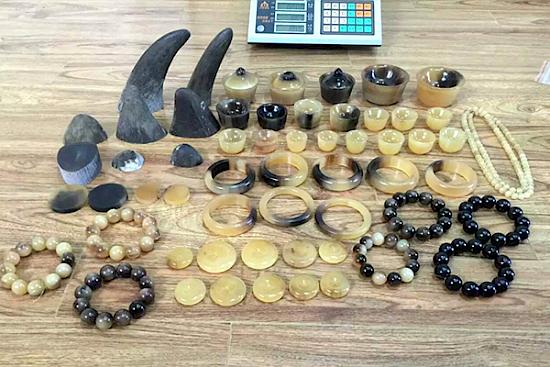About ReTTA

ReTTA is a TRAFFIC project aiming to Reduce Trade Threats to Africa’s Wild Species and Ecosystems. The project is funded by Arcadia—a charitable fund of Lisbet Rausing and Peter Baldwin.

Published 1 September 2017
Facilitated by highly adaptive transnational criminal networks, the global illegal trade in African rhino horn is driven by seemingly insatiable consumer demand in Asia. This assessment aims to deepen understanding of smuggling techniques and the highly adaptive routes that facilitate the movement of African rhino horn along the illicit rhino horn supply chain.
Report author(s):
Sade Moneron, Nicola Okes and Julian Rademeyer
Publication date:
September 2017
The report, Pendants, Powder and Pathways—A rapid assessment of smuggling routes and techniques used in the illicit trade in African rhino horn, documents recent cases in which police have discovered small home-based workshops for processing rhino horn and have seized beads, bracelets and bags of rhino horn powder.
Prior to these cases, seizures have typically comprised whole horns, or ones simply cut into two or more pieces.
It is a growing problem, the syndicates no longer want to export whole horns. They have begun cutting them up into what they call ‘disks’ and large beads in line with demand on the market side and in order to avoid detection…
Colonel Johan Jooste, national commander of the Endangered Species Section in South Africa’s Directorate for Priority Crime Investigation (DPCI)More than 7,100 rhinos have been killed for their horns in Africa over the past decade. South Africa, home to 79% of Africa’s last remaining rhinos, is the centre of the storm, suffering 91% of the continent’s known poaching losses in 2016. Facilitated by resilient, highly-adaptive criminal networks and endemic corruption in many countries along the illicit supply chain, demand for rhino horn is driven by consumers in Asia, with Viet Nam and China identified as the dominant end use markets.
Drawing on 456 seizures recorded by TRAFFIC between 2010 and June 2017, Pendants, Powder and Pathways presents a detailed overview of known smuggling routes from Africa to Asia and some of the myriad methods used by criminal networks to smuggle their contraband.
It is estimated that between 2010 and June 2017, at least 2,149 rhino horns, weighing more than five tonnes, were seized by law enforcement agencies globally.
This is a fraction of the estimated 37.04 tonnes of rhino horn obtained from the 6,661 rhinos officially reported to have been killed by poachers in Africa between 2010 and 2016 and doubtless entering illegal trade.
In most cases, rhino horn is smuggled by air. The report examines several airports in Africa and Asia that have emerged as key hotspots. At least two tonnes of rhino horn was seized at airports during the period under review, with approximately 24% of cases recorded in TRAFFIC’s seizures database involving the simultaneous trafficking of other wildlife products, particularly ivory.
The smuggling routes are complex and dynamic, exploiting weaknesses in border controls and law enforcement capacity constraints to provide a steady supply of rhino horn to Asian black markets. The routes span multiple airports, borders and legal jurisdictions, taking advantage of fragmented law enforcement responses that are hamstrung by bureaucracy, insufficient international co-operation and corruption.
Smuggling methods are infinitely versatile, limited only by imagination and opportunity. As new smuggling methods are identified by law enforcement agencies, trafficking networks adapt and refine their tactics, finding new methods of concealment and new weaknesses to exploit.

The smugglers’ efforts are sometimes crude; wrapping horns in aluminium foil, smearing them with toothpaste and shampoo to hide the smell of decay, or coating them in wax. Over time, more sophisticated methods have emerged; horns disguised as curios and toys, hidden in bags of cashew nuts, wine boxes and consignments of wood, or concealed in imitation electronic and machine parts. Circuitous transit routes, luggage drops and exchanges are used to confuse the trail.
“The domestic manufacture of rhino horn products by criminal networks in Southern Africa is likely to pose significant challenges to already over-stretched law enforcement efforts along the illicit supply chain from Africa to Asia,” said Julian Rademeyer, a Project Leader with TRAFFIC.
“It is essential there are increased resources made available to implement improved detection measures and information-sharing to counteract this alarming new development.
“It is also vital that investigations do not stop at seizures of illicit wildlife products. Rather, seizures should be regarded as a first step in broader, targeted investigations focusing on the networks and key individuals facilitating the trafficking of rhino horn and other wildlife products.”
The report was produced by TRAFFIC under the ReTTA project.
rhino horns were seized by law enforcement agencies globally between 2010 and 2017
officially reported to have been killed by poachers in Africa between 2010 and 2016
between 2010 and June 2017 were referenced for the report

ReTTA is a TRAFFIC project aiming to Reduce Trade Threats to Africa’s Wild Species and Ecosystems. The project is funded by Arcadia—a charitable fund of Lisbet Rausing and Peter Baldwin.

TRAFFIC is a registered UK charity, Number 1076722. Company Number 3785518.
Our headquarters are located at TRAFFIC, David Attenborough Building, Pembroke Street, Cambridge, CB2 3QZ
TRAFFIC is a member of the
Registered with the Fundraising Regulator
©2024 TRAFFIC INTERNATIONAL. All rights reserved.
Developed by Ian Kimber at Rochdale Online, designed by Marcus Cornthwaite.
We use cookies to enhance the functionality of this website. To learn more about the types of cookies this website uses, see our Cookie Statement. You can accept cookies by clicking the "I accept" button or by cancelling this cookie notice; or you can manage your cookie preferences via "Manage Cookies".
You can opt out of certain types of cookies (e.g. those used in social media sharing) by choosing "I do not accept". The website will still largely function well, but with slightly less functionality in places. To manage your cookie preferences in future, visit the "Cookie Statement" link at the bottom of any page.